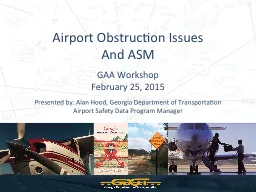/


And ASM GAA Workshop February 25 2015 Presented by Alan Hood Georgia Department of Transportation Airport Safety Data Program Manager 3 categories of approach surfaces for GA Airports State Licensing ID: 353403
Download Presentation The PPT/PDF document "Airport Obstruction Issues" is the property of its rightful owner. Permission is granted to download and print the materials on this web site for personal, non-commercial use only, and to display it on your personal computer provided you do not modify the materials and that you retain all copyright notices contained in the materials. By downloading content from our website, you accept the terms of this agreement.
Slide1
Airport Obstruction Issues
And ASM
GAA Workshop
February 25, 2015
Presented by: Alan Hood, Georgia Department of Transportation
Airport Safety Data Program ManagerSlide2
3 categories of approach surfaces for GA Airports.
State Licensing
Part 77
TERPs Visual Surface (20:1)
Approach Surfaces and Obstruction RemovalSlide3
New State Licensing
3 configurations - based on runway length
< 4,000’
4,000’ – 4,999’
5,000’ +
Meets visual approach criteria from design guide
Surface starts at threshold
Surface should be clear to meet the minimum state licensing criteria
Generally least restrictive of the three surfaces
Airports inspected biennially
New GDOT Airport Licensing Approach StandardsSlide4
GDOT Airport Licensing Approach Standards
14
32
<4000’
120’
300’
To
3000’
14
32
250’
2250’
4000’ – 4999’
14
32
400’
1800’
>5000’
1000’
To
10,300’
700’
To
5000’
15:1
20:1
20:1
500’Slide5
Obstruction Removal
obstructions should be removed immediately or removal efforts should be initiated as soon as possible with written plan provided to GDOT by specified date in letter.
if removal is not possible, displace threshold
Documentation of obstructions: biennial inspection letter
Notification
Alan Hood, Airport Safety Data Program Manager and
GDOT Project Manager
GDOT Airport Licensing Approach StandardsSlide6
Generally most restrictive, used as screening criteria
6 configurations:
Based on runway category and type of approach
<12,500lb + visual = A(V)
<12,500lb + non-precision = A(NP)
>12,500lb + visual = B(V)
>12,500lb + non-precision @ > ¾ mi visibility = C
>12,500lb + non-precision @ < ¾ mi visibility = D>12,500lb + precision = PIR
Surface starts 200’ from the end of the runway
Surface should be clear to meet FAA 5010 Safety Data Inspection Program criteria
Airports inspected biennially
Part 77 Approach StandardsSlide7
14
32
C
500’
14
32
A(V)
250’
14
32
B(V)
500’
14
32
A(NP)
500’
14
32
D
14
32
PIR
1000’
1000’
20:1
20:1
20:1
34:1
34:1
50:1
5,000’
10,000’
40,000’
Part 77 Approach StandardsSlide8
Obstruction Removal
Obstructions should be removed or provide schedule for removal
Documentation of obstructions:
biennial inspection letter
FAA 5010 report
Notification Required
Provide sketch and coordinates of cleared area
Alan Hood, Airport Safety Data Program Manager andGDOT Project Manager
GDOT will coordinate with FAA to remove from FAA database
Part 77 Approach StandardsSlide9
Surface starts 200’ from threshold
20:1 Approach Slope
Obstructions should be mitigated to maintain night minimums
When are procedures reviewed?
Any request for change in approach, name change, LOC-ID change, runway numeral change, etc
FAA performs review of airport’s terminal procedures every 2 years
FAA TERPs Visual Surface Standards
(20:1)Slide10
Previous FAA TERPs Visual Surface
Standards (20:1)
14
32
C
500’
14
32
A(NP)
500’
20:1
34:1
Part 77 surface is larger than TERPs except in A(NP) and C Category Runways with at least a Category C published approach
800’
800’
20:1
20:1Slide11
New FAA TERPs Visual Surface
Standards (20:1)
14
32
C
500’
14
32
A(NP)
500’
20:1
34:1
Surface for Categories
A – D are all same size now
400’
20:1
20:1
400’Slide12
FAA Straight-In TERPs Visual Surface
Standards (20:1)
Obstruction Removal
mitigate obstructions by:
removal
lighting
PAPI waiver – requires FAA Flight Standards approval
obstructions should be mitigated to maintain nighttime procedures.
Obstruction removal previous to “20:1” letter from Flight Procedures.
Sketch and coordinates of cleared area
Alan Hood, Airport Safety Data Program Manager and
GDOT Project Manager
GDOT notifies FAA to update databaseSlide13
FAA Straight-In TERPs Visual Surface
Standards (20:1)
If Notified by Flight Procedures of 20:1 Obstructions (After Jan 6, 2014):Slide14
Who is Responsible?
Ultimately the Sponsor
State Licensing and Part 77 Inspections: When obstructions are identified in an inspection, they become a liability.
State Licensing surface obstructions
could
lead to denial of license.Slide15
Who is Responsible?
Ultimately the Sponsor
Sponsors are also responsible for ensuring the TERPs Visual Surface is clear. Flight Procedures uses the FAA surveyed obstruction database to review procedures.
Obstructions do not automatically disappear from database with a new survey.
Must submit sketch with coordinates and boundaries of cleared areas to get obstructions removed from database.
***If you have been notified you have obstructions by Flight Procedures – then you validate the obstructions in writing. No survey or coordinates and boundaries required unless you are topping obstructions.Slide16
Questions?Slide17
Aviation System Manager (ASM)
Working on getting reporting function working.
Anticipating a Spring live date.
Live DemoSlide18
Questions?